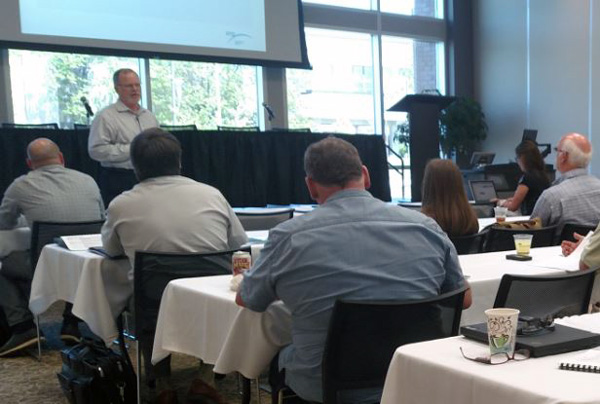Sustainability 101
By William Stough | May 19, 2016
Category:(Editor’s Note: William Stough will be leading Sustainable Manufacturer Network’s Sustainability 101 workshop June 14 at Harper College. More information and registration here.)

A strong business case can be made for implementing sustainable practices in manufacturing operations to reduce costs, increase sales, retain and attract employees, and improve investment opportunities. The case is made on the theory that what is good for the environment also is good for the bottom line. That is the tenet of Sustainability 101.
It’s becoming critical for every company to establish a sustainable manufacturing approach and strategy to help compete in a global market that will be challenged in the coming years by environmental and social pressures that never have been faced by small and mid-sized manufacturers.
You can achieve this by investing in three primary concepts: extreme efficiency, social responsibility, and systems that allow for continuous material cycling.
Leadership in extreme efficiency can add double-digit improvements to bottom line performance. Leadership in social equity is an investment in continuing productivity gains and is an insurance policy to help attract the best and brightest talent to your door. Leadership in developing cyclic closed-loop systems reduces raw material costs, improves the environmental attributes in products, and helps increase sales to the growing marketplace of green customers.
10 Steps Toward Sustainable Manufacturing

A sustainability journey of a thousand miles begins with 101.
Regardless of where you are starting, developing a sustainable manufacturing approach is easy and eminently business-savvy. The following steps will help identify the next actions to take:
- Become informed. Learn the language and concepts that form the foundation of sustainable business practices embodied in concepts such as resource productivity, design for the environment (DfE), industrial ecology and corporate social responsibility (CSR).
- Identify your baseline. To start from a strong foundation that will support future progress, measure the energy consumption, water consumption, raw material use, and waste generated in your operations.
- Develop your unique environmental vision. Every company has a set of values that lead to helping establish an environmental vision. Often these values already are embodied in various places in current management philosophy but are unarticulated. They should identify what is important to the company, such as energy efficiency, waste reduction, toxic waste, safe working conditions, green buildings, and so forth. These values can be used to establish priorities.
- Establish your performance goals. Set specific goals, (by percentage of reduction or another metric) and gauge progress against your baseline performance.
- Develop a plan to train and educate your people. Training is required for management, staff, customers, and other stakeholders to assure a common understanding and a shared commitment and language to communicate progress efficiently. Management should develop a vision; staff should determine how each position can contribute; and customers and other stakeholders can inform how their products and services will bring improvement.
- Implement internal management systems. The three core principles of extreme efficiency, social responsibility, and cyclic systems will be difficult to implement without strong management systems in place such as DfE, an environmental management system (EMS), a chemical management plan, and CSR.
- Assess progress against goals. Using internal management systems allows management to review baseline data against performance against annual goals. Many leadership companies use their management systems to develop a sustainability dashboard that is used to evaluate the success or failure of the company’s efforts.
- Review for continuous improvement. Internal assessments are critical to ensuring that the company’s efforts are continuously improving over time. This is the responsibility of management, supported by key staff to conduct internal checks, follow up corrective actions, and report back to management.
- Report progress to stakeholders. Data collected from reviewing for continuous improvement and assessment against goals can be leveraged to develop reports to stakeholders to ensure close engagement and developing strong feedback loops from key company constituencies.
- Celebrate successes. Keep morale high by recognizing and rewarding both large and small successes in the program. There is nothing worse than a company initiative that ignores the efforts invested by staff in the company’s vision.
How Global Demand Impacts Natural Resource Supply
Several major studies within the past few years suggest that the drive for businesses to sustain the global ecological systems that support their operations not only is here to stay, but is a business imperative for future success. The studies reveal an unprecedented growth in global economic affluence in new parts of the world; the increasing pace of population growth; and diminishing access to low-cost basic resources. These trends will restrain the unprepared and reward those businesses that are prepared.
Knowing how these trends will affect business and which strategies to implement will make the difference between economic failure and success.
In latter 2011, McKinsey & Co., a global business strategist to FORTUNE® 500 corporations, sounded an alarm with a groundbreaking report on business access to raw materials by 2030. A few of the report’s findings offered a stark wake-up call:
- By 2030, 3 billion additional affluent consumers will be in the global marketplace (from 1.8 billion today for a total of 4.8 billion) which will apply intense pressure on basic commodity prices.
- Steel demand is projected to rise by an estimated 80 percent.
- Global demand for clean water will outstrip supply by an average of 40 percent.
On the price side of the access-to-resources equation:
- Since 2000, real commodity prices already have increased by 147 percent
- In the past 10 years, the cost to bring a new oil well on line has increased 100 percent.
How Corporate Leaders See Sustainability
A similar global study was published in 2010 by Accenture, also a global FORTUNE 500 business strategy company. This study revealed how CEOs, presidents, and other top-level managers of large corporations rank the importance of sustainability to the success of their companies. The report included the following:
“CEOs around the world are starting to see the shape of a new era of sustainability coming into view. In the face of rising global competition, technological change, and the most serious economic downturn in nearly a century, corporate commitment to the principles of sustainability remained strong throughout the world: 93 percent of CEOs see sustainability as important to their company’s future success.”
Additional findings include:
- 91 percent of CEOs report that their companies will employ new technologies (renewable energy, energy efficiency, information and communication) to address sustainability
- 72 percent of CEOs cite “brand, trust, and reputation” as one of the top three actors driving them to take action on sustainability; revenue growth and cost reduction were second at 44 percent.
These and other respected global business analysts are saying with increasing frequency that the foundational issues at the heart of the sustainability phenomenon— increasing global consumption and the resulting ecological assault on Earth’s living systems—are having a negative impact on the “business as usual” model.
In contrast, the sustainable business approach offers manufacturers a strategic path through an uncertain future. Its tenets are based on incorporating extreme operational efficiency, socially responsible stakeholder collaborations, and safe and reusable material flows. Each of these three major tactics offers an opportunity to reduce costs, enhance the company’s reputation, and increase sales to the growing segment of ecologically-minded customers.
Extreme Operational Efficiency
Many of the benefits of extreme operational efficiency came from the initial resource stewardship demonstrated by the inventor of modern manufacturing, Henry Ford. His work was transmitted to the scientific approach developed by Edward Deming which led to lean manufacturing. His lean approach was then capitalized upon by Sakichi Toyoda with his just-in-time (JIT) delivery concept and the resulting Toyota Production System (TPS).
These pioneers set the standard for identifying and eliminating waste from a manufacturing system. Additional principles of sustainability (lean and clean) have pushed the original lean manufacturing to a higher performance plateau.
The lean and clean mindset not only includes the traditional seven lean wastes, but also incorporates energy and material efficiency as well as the use of safer chemicals to identify and reduce the total cost of production from raw material extraction to the product’s end of life.
Socially Responsible Stakeholder Action
Societies give businesses their legitimacy to perform needed functions. This is manifested in the laws enacted by local, state, and national governments to protect the quality of life for each constituency. A license to operate permits that demonstrate compliance, and continued customer support affect how investors, future employees, and the community views the company as either a valued or unwanted corporate citizen.
Socially responsible stakeholder partnerships support the notion that there is business value in establishing outreach programs to key stakeholders. Reaching out to employees, the community, government regulators, and potential investors to gain insights into their needs, wants, and concerns has business value. Manufacturers can take advantage of what is learned and take preventive action.
As noted, reputation plays a key role in one of the most critical business challenges facing a business in a growing market – access to the best and brightest talent. Strategically applied socially responsible stakeholder collaborations are attracting and retaining talent, supporters, and investors; lowering recruiting costs; and increasing innovation and productivity.
Implementing Closed-Loop Material Flow Systems
Original equipment manufacturers (OEMs) are focusing on their supply chains’ sustainability to help reduce the total environmental impact of the products they sell.
To test the business case for this approach, take a walk out into your shop and ask yourself, “How often is a unit of energy, raw material, or water used; contaminated with a foreign substance along the way; and disposed of after one use?” It happens all too frequently. This drives up operational costs, increases labor and inhibits achieving optimal productivity gains.
Leadership companies implement programs to capture every Btu of energy possible and find ways to reuse it in a cascading sequence until the useable energy content finally is extracted.
Also they are not satisfied with reaching standard industry scrap rates, but work to improve their performance through lean and clean evaluations to continuously increase their first-pass yield to drive down raw material purchasing cost.
More attention is given to improving chemical characteristics to ensure that what is generated as a waste is nonhazardous, and can be sold as a reusable material input to a buyer. These techniques help to create a closed-loop system of material reuse instead of using energy and materials once and then paying high prices to dispose of them as specially regulated waste. Through their own in-house experiences, OEMs see a tremendous cost reduction opportunity by collaborating with sustainable supply chain partners.

Side by side, we move metal fabrication forward.
FMA unites thousands of metal fabrication and manufacturing professionals around a common purpose: to shape the future of our industry, and in turn shape the world.
Learn More About FMA


